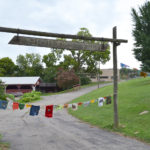























Installation at the Abraham Lincoln statue, Avondale
Prayer Flags for Cincinnati Acrylic on found fabric 2017Located in Avondale, the flags were installed at the location of the June 1967 arrest of Peter Frakes, who was booked for loitering whilst protesting the disputed conviction of Posteal Laskey Jr. In response to Frakes’ arrest, crowds filled the streets, threw bottles and firebombs at businesses and ultimately the Ohio National Guard was called in to restore order. By the end of the uprising, one person died and there were 404 arrests. In 1968, President Lyndon Johnson’s Commission on Civil Disorders issued a report that blamed the riots on the poverty of the segregated neighborhoods in Cincinnati and the practice of police officers in unlawfully targeting African Americans and using loitering laws disproportionately against minorities. The events of 1967 helped fuel beliefs that the city was too dangerous for families and helped accelerate flight to the suburbs. As a result, between 1960 and 1970 the city of Cincinnati lost 10% of its population, compared to a loss of just 0.3% from 1950 to 1960 and the city would continue to lose residents every decade afterwards.
Prayer Flags for Cincinnati was a collaborative project featuring the perspectives and input of local Cincinnati residents which inspired both the themes and images of the flags created as well as their locations of installation. The homemade flags are modeled after Tibetan prayer flags, traditionally hung around homes, villages, and sacred sites and are believed to ward off evil spirits and bring luck to those touched by the winds that pass through the flags. Instead of using the traditional dyed cottons and mass woodblock printing, the flags are made out of the scraps of everyday life, including clothing, doilies, handkerchiefs, napkins, tablecloths, pillowcases and curtains. Images of Cincinnati’s triumphs, the dreams of its residents and most importantly, the toughest of its struggles are hand-painted onto each fabric flag. These experiences are literalized through hand-painted imagery, emerging from the cloth as either prideful adornment or through the form of a stain on the surface of the fabric.
























